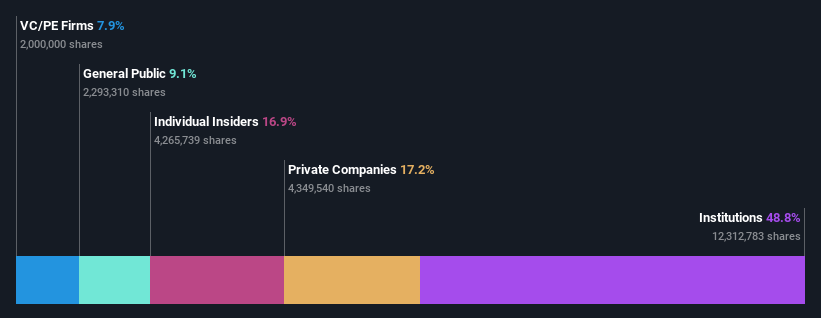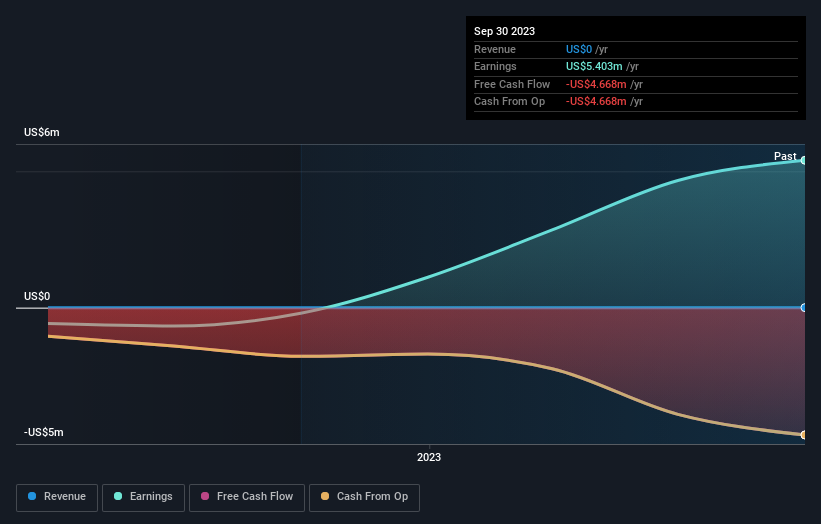Owning 49% shares,institutional owners seem interested in FTAC Emerald Acquisition Corp. (NASDAQ:EMLD),
Key Insights
Significantly high institutional ownership implies FTAC Emerald Acquisition's stock price is sensitive to their trading actions
A total of 5 investors have a majority stake in the company with 55% ownership
Every investor in FTAC Emerald Acquisition Corp. (NASDAQ:EMLD) should be aware of the most powerful shareholder groups. We can see that institutions own the lion's share in the company with 49% ownership. Put another way, the group faces the maximum upside potential (or downside risk).
Because institutional owners have a huge pool of resources and liquidity, their investing decisions tend to carry a great deal of weight, especially with individual investors. Therefore, a good portion of institutional money invested in the company is usually a huge vote of confidence on its future.
In the chart below, we zoom in on the different ownership groups of FTAC Emerald Acquisition.
See our latest analysis for FTAC Emerald Acquisition
What Does The Institutional Ownership Tell Us About FTAC Emerald Acquisition?
Institutional investors commonly compare their own returns to the returns of a commonly followed index. So they generally do consider buying larger companies that are included in the relevant benchmark index.
We can see that FTAC Emerald Acquisition does have institutional investors; and they hold a good portion of the company's stock. This implies the analysts working for those institutions have looked at the stock and they like it. But just like anyone else, they could be wrong. It is not uncommon to see a big share price drop if two large institutional investors try to sell out of a stock at the same time. So it is worth checking the past earnings trajectory of FTAC Emerald Acquisition, (below). Of course, keep in mind that there are other factors to consider, too.
FTAC Emerald Acquisition is not owned by hedge funds. Our data shows that Emerald ESG Sponsor, LLC is the largest shareholder with 17% of shares outstanding. Meanwhile, the second and third largest shareholders, hold 17% and 7.9%, of the shares outstanding, respectively.
Our research also brought to light the fact that roughly 55% of the company is controlled by the top 5 shareholders suggesting that these owners wield significant influence on the business.
Researching institutional ownership is a good way to gauge and filter a stock's expected performance. The same can be achieved by studying analyst sentiments. Our information suggests that there isn't any analyst coverage of the stock, so it is probably little known.
Insider Ownership Of FTAC Emerald Acquisition
While the precise definition of an insider can be subjective, almost everyone considers board members to be insiders. Management ultimately answers to the board. However, it is not uncommon for managers to be executive board members, especially if they are a founder or the CEO.
Most consider insider ownership a positive because it can indicate the board is well aligned with other shareholders. However, on some occasions too much power is concentrated within this group.
It seems insiders own a significant proportion of FTAC Emerald Acquisition Corp.. Insiders own US$25m worth of shares in the US$151m company. It is great to see insiders so invested in the business. It might be worth checking if those insiders have been buying recently.
General Public Ownership
The general public, who are usually individual investors, hold 9.1% stake in FTAC Emerald Acquisition, which represents a relatively small class of owners. Thus, only a relatively small part of the company is held by retail investors. Since they are only a small group of shareholders in the company, there's little they can do if their interests are not prioritized.
Private Equity Ownership
Private equity firms hold a 7.9% stake in FTAC Emerald Acquisition. This suggests they can be influential in key policy decisions. Some investors might be encouraged by this, since private equity are sometimes able to encourage strategies that help the market see the value in the company. Alternatively, those holders might be exiting the investment after taking it public.
Private Company Ownership
We can see that Private Companies own 17%, of the shares on issue. Private companies may be related parties. Sometimes insiders have an interest in a public company through a holding in a private company, rather than in their own capacity as an individual. While it's hard to draw any broad stroke conclusions, it is worth noting as an area for further research.
Next Steps:
While it is well worth considering the different groups that own a company, there are other factors that are even more important. Consider for instance, the ever-present spectre of investment risk. We've identified 3 warning signs with FTAC Emerald Acquisition , and understanding them should be part of your investment process.
Of course, you might find a fantastic investment by looking elsewhere. So take a peek at this free list of interesting companies.
NB: Figures in this article are calculated using data from the last twelve months, which refer to the 12-month period ending on the last date of the month the financial statement is dated. This may not be consistent with full year annual report figures.
Have feedback on this article? Concerned about the content? Get in touch with us directly. Alternatively, email editorial-team (at) simplywallst.com.
This article by Simply Wall St is general in nature. We provide commentary based on historical data and analyst forecasts only using an unbiased methodology and our articles are not intended to be financial advice. It does not constitute a recommendation to buy or sell any stock, and does not take account of your objectives, or your financial situation. We aim to bring you long-term focused analysis driven by fundamental data. Note that our analysis may not factor in the latest price-sensitive company announcements or qualitative material. Simply Wall St has no position in any stocks mentioned.

 Yahoo Finance
Yahoo Finance 

